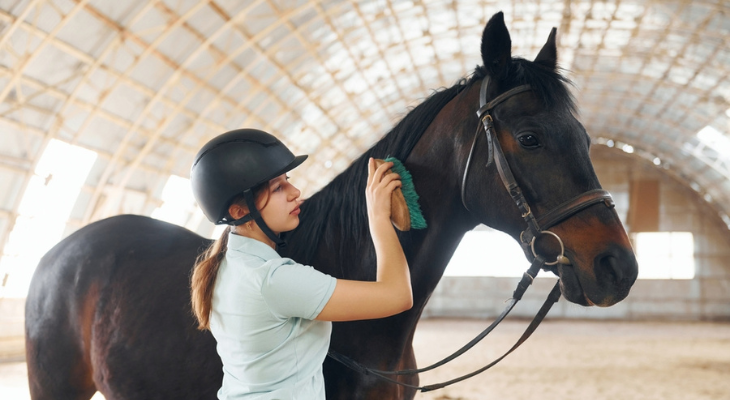
Grooming Your Horse: How Frequently Do You Need to Complete This Essential Horse Care Task?
Grooming not only improves your horse's appearance, but also provides a few important health benefits. Although the ideal grooming schedule varies from horse to horse, regular grooming helps your horse look and feel its best.
When Is the Best Time to Groom Your Horse?
Your horse's grooming schedule depends on its activity level. Although daily grooming is always helpful, you may only need to groom your horse three or four times a week if it isn't very active. Working or active horses benefit from daily grooming.
Grooming Benefits
Regular grooming is essential for healthy skin and keeps your horse's coat in good condition. Brushing your horse removes dirt, dust, loose hair, and dead skin cells and evenly distributes skin oils that make its coat look sleek and shiny. Grooming also increases blood flow to the skin and muscles. Blood contains nutrients that nourish the skin and muscles.
When you groom your horse daily, you're more likely to notice lumps, hot spots, sore areas, irritated skin, cuts, or other health issues. Have you ever tried to walk with a pebble stuck in your shoe? Your horse is just as uncomfortable when rocks or debris stick to its hooves. Picking debris out of your horse's feet during a grooming session protects your horse's feet and legs and helps your horse avoid infections that could cause lameness.
Best of all, regular grooming sessions give you the opportunity to spend one-on-one time with your horse. These sessions can be a relaxing way to start or end the day for both you and your horse. Grooming may also alert you to subtle changes in your horse's mood or personality. The American Quarter Horse Association notes that paying attention to your horse's mood when grooming can act as an early warning system and let you know when something isn't quite right.
What Does the Ideal Grooming Session Involve?
Although your routine may vary slightly, grooming should include:
- Using a Curry Comb. Curry combs contain multiple rubber or plastic teeth ideal for spreading skin oils, removing stray hair and dirt, and pulling dust from the deeper layers of the coat. Use a circular motion as your brush your horse's coat from neck to tail. If your horse is muddy, wait for the mud to dry before using the curry comb.
- Brushing Your Horse. Start with a stiff brush to get rid of dirt loosened with the curry comb. The Rutgers Cooperative Extension recommends using short strokes, as long strokes may spread dirt from area to area. After brushing your horse's body with the stiff brush, switch to a soft brush. The soft brush removes any remaining dirt and loose hair and improves the appearance of your horse's coat. Unlike other brushes, soft brushes can also be used on the face.
- Detangling the Mane and Tail. Use a main and tail comb to gently remove tangles and knots in these areas. Start at the bottom of the mane or tail and work your way up. Applying a detangling product before you start working can make this task a little easier.
- Picking Your Horse's Foot. Remove rocks, dirt, and debris from your horse's foot with a hoof pick. It's best to start at the heel and work your way toward the toe. The Rutgers Cooperative Extension notes that picking from the toe toward the heel could injure the frog if your horse suddenly moves its foot. During foot cleaning, make sure horseshoes are securely fastened to the foot.
- Cleaning the Face. A damp washcloth or sponge removes debris from your horse's face, including the nostrils, eyes, and ears.
Have you noticed any potential health problems with your horse during a grooming session? An appointment with the equine veterinarian can help put your mind at ease. Contact our office to schedule a visit for your horse.
Sources:
American Quarter Horse Association: Horse Grooming Basics, 4/10/2018
https://www.aqha.com/-/horse-grooming-basics
National Ag Safety Database: Rutgers Cooperative Extension: Grooming Horses Safely
https://nasdonline.org/227/d000026/grooming-horses-safely.html
Horse & Rider: The Lesser-Known Benefits of Grooming Your Horse, 4/12/2023
https://horseandrider.com/horse-health-care/benefits-of-grooming-your-horse/
Horse Illustrated: Groom Your Horse Like a Pro, 3/19/2019
https://www.horseillustrated.com/groom-your-horse-like-a-pro
